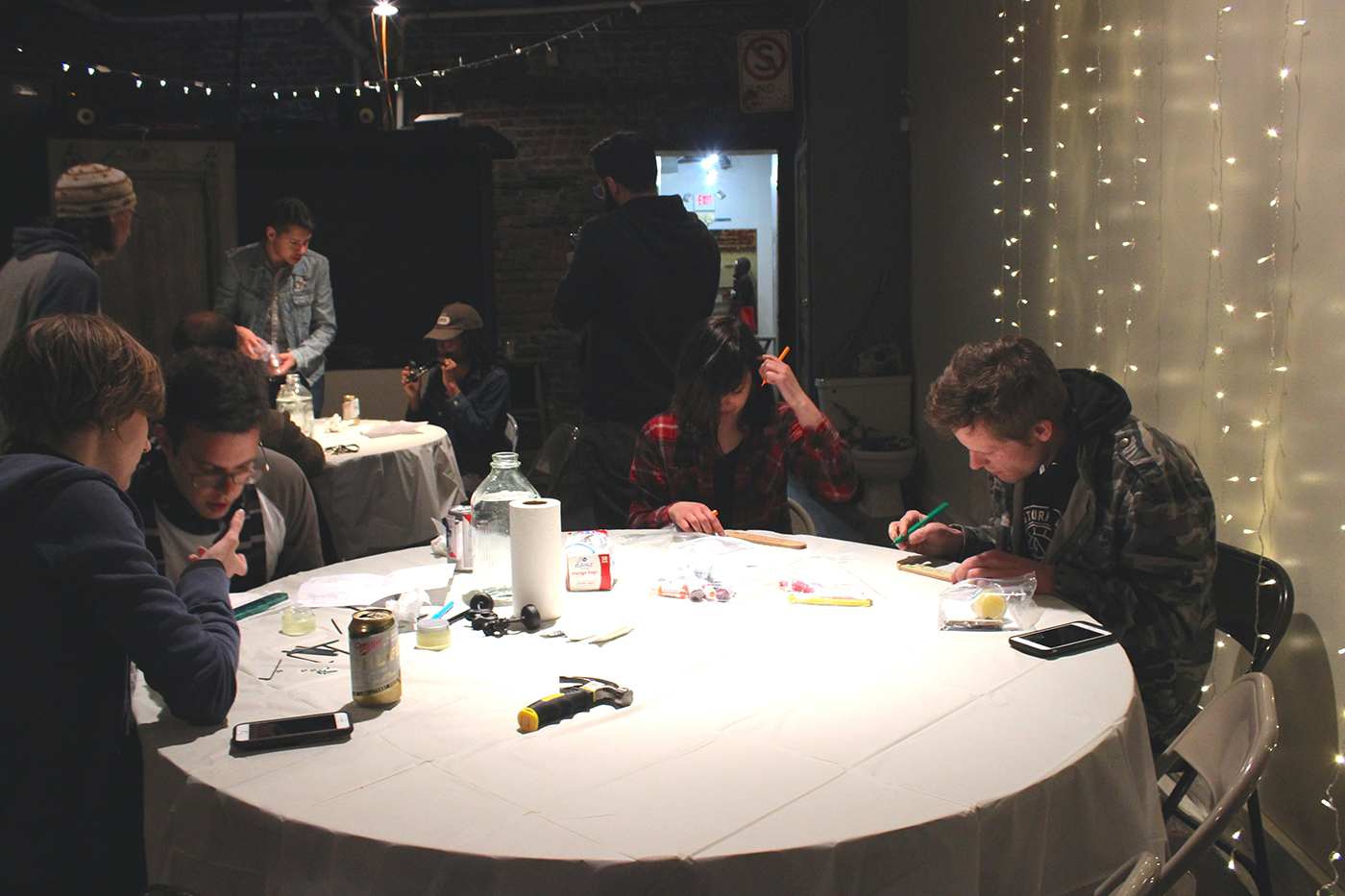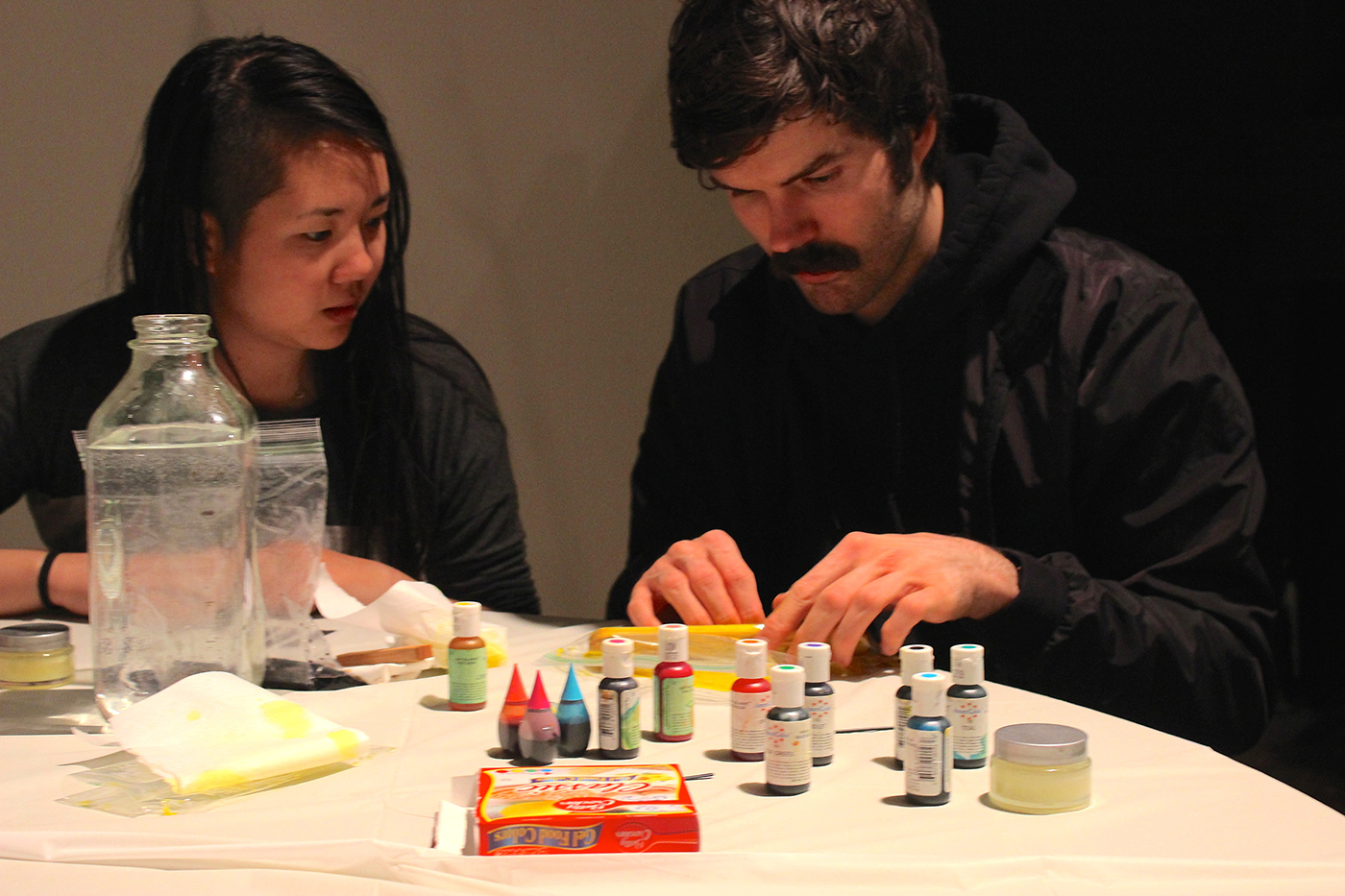
Chris Reilly’s ‘Intimate Instruments’ workshop explores the potential depth of human connection
Above: The workshop at Spread Art, with participants working alone or in couples to create their linguaphones.
How do you experience intimacy? Is it something you can get better at with practice? Artist and Eastern Michigan University professor Chris Reilly would like you to consider your relationship with intimacy, and to this end, facilitates workshops that invite participants to assemble and play an instrument of his own devising, called the “Linguaphone of Tremulous Communion.” On Saturday, May 14th, Reilly held one of these Intimate Instrument Workshops, which is the culmination of his recent residency at Spread Art in Detroit–part of a residency program that recently received a Knight Arts grant.
During the workshop, participants are provided with a kit that includes all the necessary components for constructing one of Reilly’s proprietary instruments. The finished product has some conceptual overlap with a thumb harp or kalimba, but the spring steel keys and frets are mounted on a dense bar of hickory, rather than a vessel, which would amplify the sound for an audience. In fact, the linguaphone has an audience of two—the two players, who activate the instrument by biting down on either side of the wooden bar, which enables the vibration caused by playing the instrument to be heard almost entirely within their skull cavities. The result is a very personal and private exchange between two people, facing each other from several inches away, and joined at the mouth by a communication device that sends vibrations directly through the teeth and into the bones. It is intimate, to say the least.

A couple of attendees work on decorating their linguaphones.
Reilly’s work, especially the work he created in the context of his UCLA graduate program in 2013, deals quite a bit with vulnerability and human connection. This area of interest was directly informed by the long-distance relationship he maintained at the time, which resulted in collaborative projects between him and his partner, such as the development of a body-mounted camera system that he characterizes as “physical Facetime,” and an exchange of used bed sheets that reached a hot-and-heavy pitch over the course of 10 weeks.
The first Intimate Instruments Workshop was held in Los Angeles in 2013, and since then Reilly has done two that took place in Ljubljana, Slovenia in 2015, and the fourth at Spread Art last weekend. “People love it!” Reilly enthuses, and indeed, he has honed the format to expertly draw participants into an experience that takes a sudden turn for the intimate. Many attendees at the workshop arrived with a partner; as a single attendee, it wasn’t until I had navigated the fun of building and customizing my linguaphone that I realized I was on the hook to also build a human connection with someone.
Reilly saw me hanging, and came over to take the second player position. The distance, which is close from outside observation, is excruciatingly intimate in practice. Being connected to someone by a mouth instrument, even one as platonic as a thumb harp, is pretty personal. The positioning makes eye contact unavoidable, and negotiation of the interstitial space between players is critical. I was grateful that Reilly is a seasoned participant in these workshops, and able, through good humor and a strong intimacy practice, to make this close encounter more funny than uncomfortable for me, a novice at both music and intimacy.

The author’s assembled linguaphone, designed to maintain boundaries, even within intimacy.
Reilly’s linguaphone is a perfect embodiment of his artistic efforts to uncover a mechanism that binds participants into a physical dialogue, providing a shared sensory experience that bypasses the intellectual filter of conversation. Reilly considers playing the linguaphone to be a kind of synesthesia, plugging participants into a low-stakes activity that might take them to unexpectedly deep places.
“It’s easy to overlook non-romantic intimacy, or think that doesn’t count as valid experience,” he says. “But it blurs so much more than you think it would.”
You can learn more about Spread Art’s residency program on their website and look through their archive of past residents here. Keep your eyes peeled for upcoming excitement, as they leverage their Knight Arts funding to bring more residency activities to Detroit.
Recent Content
-
Artsarticle ·
-
Artsarticle ·
-
Artsarticle ·
